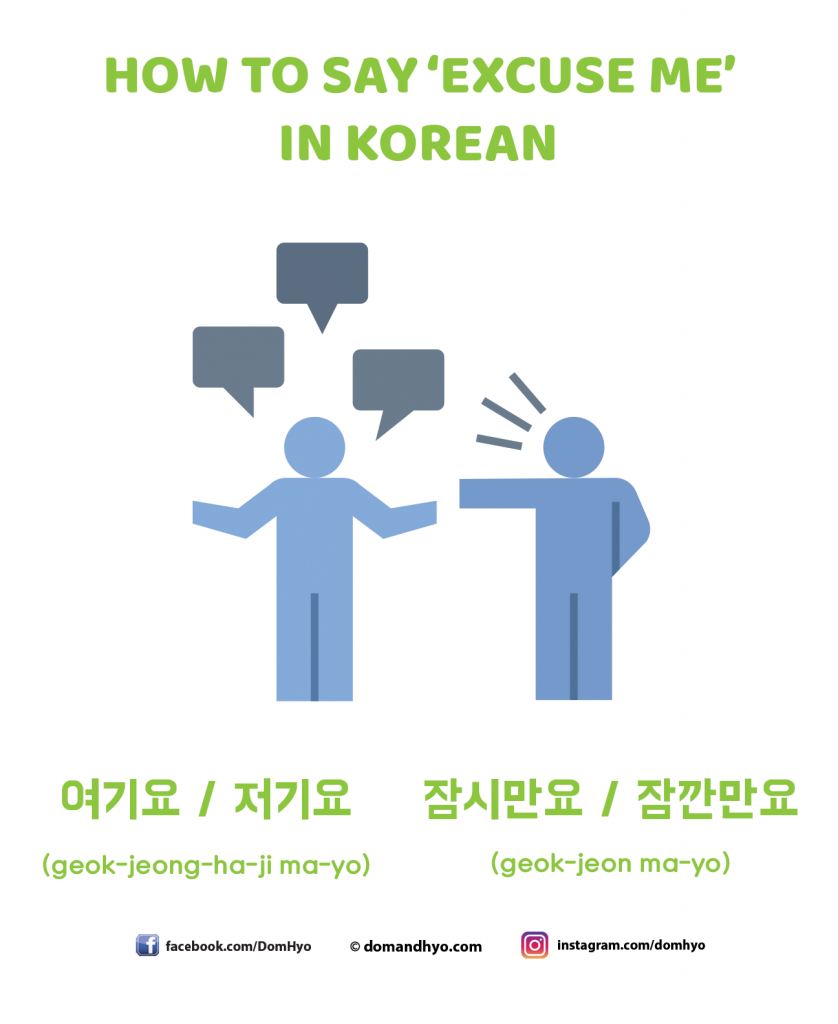
You’re on the crowded train or bus, and you need to get through. You’re at the market, and someone’s cart is in the way. How can you politely say ‘excuse me’ so you can get by? Well today, we’re going to show you how.
Now there are lots of different situations you can use the following phrases for. You could be at the restaurant or in one of the situations above. Let’s start breaking them down for you!
실례합니다 (sil-lye-ham-ni-da)
This is the actual, standard definition of ‘excuse me’ that you will most often. There’s one big problem though. It’s not commonly used in spoken Korean! It’s very formal and polite and may sound a bit awkward. Now using this won’t be a problem and Koreans will understand you, but if you want to sound a little more natural, there are some other versions of ‘excuse me’ that you can use.
When I first started learning Korean, I used this quite often since my lessons hadn’t covered any other ways to say excuse me yet. So when in doubt, feel free to use this one.
This phrase comes from ‘실례’ which means a breach of etiquette, incivility, or discourtesy. Then added on to it is a formal ending to sound polite. Here are some examples.
실례합니다. 이 재킷 얼마예요? (sil-lye-ham-ni-da. i jae-kit eol-ma-ye-yo) = Excuse me. How much is this jacket?
실례합니다. 거기는 제 자리인데요. (sil-lye-ham-ni-da. geo-gi-neun je ja-ri-in-de-yo) = Excuse me. I believe this is my seat.
여기요/저기요 (yeo-gi-yo/jeo-gi-yo)
If you’d like to get someone’s attention, you can use these two. The direct translation for 여기요 is ‘here’ and the direct translation for 저기요 is ‘there’. You can still use both to get someone’s attention, specifically in a restaurant when you’re trying to get the server’s attention. If you’re ever in Korea and head out to visit some restaurants, this is such a useful phrase to add to your arsenal. These are quick and easy to learn, and they’re words you can apply immediately in real life situations. Here are a few examples of both.
저기요. 거기 누구 있어요? (jeo-gi-yo. geo-gi nu-gu i-sseo-yo) = Hey. Is anyone there?
저기요? 들리시나요? (jeo-gi-yo? deul-li-si-na-yo) = Excuse me. Can you hear me?
저기요. 녹차는 어디에 있나요? (jeo-gi-yo, nok-cha-neun eo-di-e in-na-yo) = Excuse me. Where can I find the green tea?
Using Titles to Get Someone’s Attention
Koreans rarely address each other directly by name. Depending on one’s relationship, you will refer to them with a title like ‘오빠’, ‘언니’, ‘누나’, etc. You can use these titles to call out to someone to get their attention as well. Out in public, these titles would include 아저씨 (used for older men, usually in their 40s and above), 아줌마 (used for very old women, but can be offensive depending on context), 기사님 (driver of a bus or taxi), and 사장님 (boss or business owner). For more titles, you can use, check out this infographic we did on the topic here.
아저씨 여기 어디에요? (a-jeo-ssi yeo-gi eo-di-e-yo) = Excuse me (ajessoshi). Where is this place?
죄송합니다 (joe-song-ham-ni-da)
If you’ve seen our post on How to Say Sorry in Korean, you’ll know that this is one of the phrases Korean use. It can also be used to say excuse me if you bump into someone in public or need someone to repeat something they said.
죄송합니다. 다시 한 번 말씀해 주세요. (joe-song-ham-ni-da. da-si han beon mal-sseum-hae ju-se-yo) = Excuse me. Could you repeat that?
죄송합니다. 일부러 부딪친 것은 아니에요. (joe-song-ham-ni-da, il-bu-reo bu-dit-chin geo-seun a-ni-e-yo) = Excuse me. I didn’t mean to bump into you.
죄송하지만 누구세요? (joe-song-ham-ni-da. nu-gu-se-yo) = I’m sorry but who are you?
잠시만요/잠깐만요 (jam-si-ma-nyo/jam-kkan-ma-nyo)
Next, we have two phrases that are directly translated as ‘wait a moment’ or ‘wait a second’. However, like the above phrases, it can be used in public when you are trying to get through a crowd of people (especially during rush hour on the subway or bus here in Seoul!). You can simply use this expression by itself when someone or a group of people is in your way. You can drop the ‘요’ if you want to use these towards people younger than you or close to you.
Practice and memorize these phrases so you’ll know when to use them in the appropriate situations.
